POSSIBLE CAUSES OF CHANGES IN THE INTESTINAL MICROBIOME
Abstract
Irritable bowel syndrome (IBS) is one of the most common gastrointestinal tract (GIT) diseases. The prevalence of IBS in Europe and North America is approximately 9.8%-12.8%. At the same time, 27-82.6% of patients with IBS have symptoms of functional dyspepsia (FD). The disease significantly worsens the quality of life, reduces the social activity of patients, and requires significant material costs for their examination and treatment. If the diagnosis of IBS is established only on the basis of patient complaints, the absence of alarm symptoms and a minimum number of laboratory and instrumental studies, as recommended in the Rome III criteria, the probability of making an incorrect diagnosis remains quite high (up to 25%). The effectiveness of most recommended drugs and regimens in the treatment of IBS does not exceed 38%, which indicates insufficient study of the pathogenesis of the disease. Approaches to the treatment of combined functional gastrointestinal disorders (for example, IBS and functional dyspepsia syndrome) have not been developed. In recent years, studies have shown that in addition to the emotional component, structural changes contribute to the development of IBS symptoms. The following are discussed: increased intestinal wall permeability due to impaired synthesis of proteins that form tight junctions between epithelial cells ; changes in the expression of signaling receptors that mediate the interaction of the host organism with bacterial cells; abnormal cytokine profiles with increased levels of proinflammatory cytokines; the presence of nonspecific inflammation in the intestinal wall; and changes in the qualitative and quantitative composition of the intestinal microflora. However, the relationship between the above changes and the development of disease symptoms remains poorly understood. It seems relevant to conduct a more in-depth study of the structure of functional diseases; assess the feasibility of performing a set of laboratory and instrumental examinations to establish a diagnosis; and determine optimal treatment regimens for such patients depending on the effect of drugs on the underlying mechanisms of symptom development.
Downloads
Published
Issue
Section
License

This work is licensed under a Creative Commons Attribution-NonCommercial-NoDerivatives 4.0 International License.















